Isaac E. Keys ~ "Sign of the Black Boot" ~ A Leather Merchant in Waynesville
Samuel Heighway from Shropshire, England founded Waynesville, Ohio in 1797. His settlement was honed out of the woods and clung tenaciously to the side of a steep hill overlooking the flood plain of the meandering Little Miami River. It was a tiny hamlet of a few log cabins and a tavern encircled by a dense and undisturbed wilderness. However, Waynesville’s growth, and the settlement of the surrounding area, would be phenomenal during its first decade due to the influx of pioneers.

Israel Hopkins Harris
b. in Centerville, Ohio, November 23rd, 1823
d. in Waynesville, Ohio, October 17th,1897
Israel Hopkins Harris was one of the five children of James and Rebecca Clark Jennings Harris.
His father, James Harris, had a farm south of Centerville and was a very successful dry goods businessman. He clerked first in the store of John Satterthwaite in Waynesville. After his marriage the Harris family moved to Centerville where he opened his own store. He later opened stores in both Waynesville and in Bellbrook. James Harris was also one of the first pork packers in the area as well as one of the first tobacco buyers. In 1844, the Harris family moved back to Waynesville.
Israel Hopkins Harris was schooled in Centerville by the noted teacher, David Burson, and in Franklin by W. C. Gould. He entered the Junior class at Yale in 1844. He graduated from Yale in 1846. When he returned to Waynesville after his graduation, he worked with his father in his dry goods business. After the death of James Harris, I. H. Harris partnered with his brother Joseph and continued in his father's business from 1849-1855. He consequently went into partnership with Jarvis Stokes of Lytle, Ohio to open a bank. I. H. Harris and Jarvis Stokes continued in the banking business until the death of Mr. Stokes in 1868. I. H. Harris continued the bank, the "I. H. Harris Exchange Bank" until his death.
I. H. Harris was married three times:
While attending Yale University, I. H. developed a deep interest in geology and became an avid collector of geological and archaeological specimens. His private collections of artifacts was world famous. He also collected fresh water pearls found in the mussels in the Little and Great Miami Rivers. He owned and operated the "Little Miami River Pearl Fisheries". He left his prestigious collection of geological and archaeological specimens to the Smithsonian Institute in Washington, D. C. In 1888 he sold over 2,000 fresh water pearls to Tiffany & Co.
The following is taken from the
"Memoir of Israel Hopkins Harris" by Charles F. Mosher
"The Old Northwest Genealogical Quarterly", April 1898
"In person Mr. Harris was slender and rather below medium height. He had the eagle nose and eye which are the marks of great power and force of character. In later years an iron gray mustache slightly veiled his firm, yet sympathetic mouth. A high forehead indexed the keen intellect behind it. He inherited intense vitality, and all his life long was much in the open air. Even at an age when most men begin to seek easy chairs and dread exertion, his energy led him to continue his outdoor exercise, and the last letter the writer ever received from him was in reference to a contemplated fishing excursion of some days' duration ~~preparations for which were interrupted by the short illness preceding his death.
Mr. Harris was a great believer in the benefits of pedestrianism, and no one ever visited Waynesville without carrying away a memory picture of him taking his daily walk over to the railroad station (Waynesville Depot in Corwin, Ohio) to meet the evening train, sometimes accompanied by his younger daughter or one of his grandchildren, but more often alone. His erect form, alert air, quick, nervous step and cheery greeting of friends~~for all who knew him were his friends ~~made an impression never to be forgotten.
Learned as few men are today, an ardent student to the last, a successful man of business, a loved and honored husband and father, an ideal gentleman~~he was all these things and more. Culture did not make him careless of the feelings of others less gifted than himself, and some of his warmest friedns were men who stumbled at the very names of the studies he so loved. The keen intellect which trcced the workings of Supreme Intelligence through countless ages without bewilderment or faltering, was no more marked in him than the great heart which beat in sympathy with every noble aim and action. The relentless critic of all shams, he was the friend of every one whose sincere desire it was to develop to the full those qualities which raise mankind above the brutes. Many who could not define the method, appreciated the result in themselves; and when the long, as that of one great household for the departure of its counselor, busy, fruitful life drew to a close, Waynesville's mourning was leader and friend.
Also see, "The Harris Guards" ~ Ohio National Guard in Waynesville (more family photos)
Also see, I. H. Harris, Banker, Tells a Funny Story
MORE PHOTOGRAPHS OF THE HARRIS FAMILY:
Israel Hopkins Harris (first three photos)
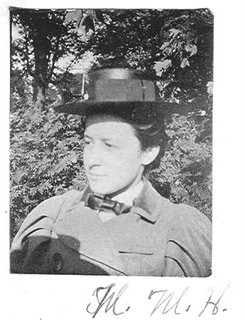
Minnie Mildred Harris ~
I.H. Harris' daughter by third wife ~ Edith Mosher

This military unit performed at various functions in the community. For example, this story of their visit to Springboro found in the Wester Star newspaper of Lebanon, Ohio on June 26, 1879:
SPRINGBORO: The visit of the military company and band from Waynesville on Saturday evening, was greeted by our citizens with pleasure. The drill and music were excellent. But after partaking of an excellent supper, provided by the ladies, the music failed, only playing one tune after supper. Whether from eating too hearily or drinking too freely, or from sheer cussedness we cannot say. A few of the band tried to prevail on the others to redeem their credit, but failed. The officers of the military company were greatly mortified at the conduct of the band. May people who came in from the country were disappointed. We do not think our people will invite the band to visit us soon again. The conduct of the millitary was quite different. They were willing and cheerful and pleasant and sober. They used a drill new to most of our soldiers. They were highly complimented all around. Come again, boys.
The "Harris Guards" of the Ohio National Guards stationed in Waynesville did see some action in 1884 during the Courthouse Riots in Cincinnati. These riots were the worst riots ever experienced in Ohio. There had been a spree of violence and murder in Cincinnati. When two Cincinnati men murdered their employer but received a lenient sentence, 8,000 Cincinnati citizens angered at the corruption in the local court system, stormed the Hamilton County prison and the courthouse. In a fury at the increasing murder rate, the courthouse was burned to the ground. The riot lasted three days and 50 people were killed and 250 people were injured. ONG units from Dayton, Columbus, Cleveland as well as Waynesville were called up to service.
OFFICERS:
Captain James A. Kearney
Captain James A. Kearney, druggist and Postmaster, Waynesville; born in the county of Kerry, Ireland, January 24th, 1846. He was a son of Patrick and Sophia (Apjohn) Kearney, natives of Ireland. Our subject as three years of age when brought to this country. . . In 1865, Patrick Kearney came to this county and located on a farm near Waynesville. . . At the trial of our Government’s strength in the war of the rebellion he (Captain James A. Kearney) came forward to her support by enlisting Aug. 8th, 1861, in the naval service, being at the time of his 16th year of age. He served about two and one-half years and resigned, turning to Cincinnati and engaged in various capacities in the employ of the government till the close of the war, after which Mr. Kearney engaged in mercantile trade at sundry places in the States of Alabama and Arkansas; thence for a time engaged in the employ of railroad companies in the South. In the fall of 1877 Mr. Kearney returned to Waynesville and engaged as a clerk in the drug business and in the Spring of 1880 he purchased a new stock of drugs and entered upon trade on his own account; and April 22nd, 1881, received the appointment as Postmaster of Waynesville (The History of Warren County,Ohio [Chicago: W. H. Beers & Co.], p. 862.)
John Jacob Mosher, First Lieutenant
January 8th, 1857 ~ June 9th, 1894
John Jacob Mosher (known as "Jake") was one of the ten children of Nathan Nicholas and Sarah Ann Bovy Mosher. He was married to Laura Henrietta Harris, the daughter of Israel Hopkins Harris, a highly successful businessman and banker in Waynesville, and his second wife. From 1872 to 1878, John Jacob's father Nathan was the innkeeper of the Hammell House in Waynesville. Nathan Nicholas Mosher had fought in the Civil War, was disowned by the Quakers, had a farm in Morrow County, Ohio, after the Civil War lived in Kansas and Iowa, came then to Waynesville and eventually moved to Cincinnati where he worked on the Cincinnati Times, returning to Mount Gilead in Morrow County in 1895. Nathan died there in 1916. When Nathan moved to Cincinnati, two of his children stayed in Waynseville: Edith Mosher and John Jacob Mosher. Edith Mosher married Israel Hopkins Harris (his third wife). Her younger brother, John Jacob then married her step-daughter, Laura Henrietta Harris on June 6, 1883. "Jake" Mosher worked for his father-in-law, Israel Hopkins Harris in the Harris Exchange Bank. "Jake" died eleven years later at the age of 37 of pneumonia. Three years later Israel Hopkins Harris died and Edith Mosher Harris (his thrid wife) and her step-daughter Laura Henrietta Harris Mosher moved in together. They were both active in St. Mary's Episcopal Church in Waynesville.
John Jacob and Laura Henrietta Harris Mosher had three children: Carrie (Carolyn), Edith and Harris (Information taken from: Descendants of Hugh Mosher and Rebecca Maxson Through Seven Generations, Rev. Ed., compiled by Mildred (Mosher) Chamberlain and Laura (McGaffey) ClareAuthor: Mildred (Mosher) Chamberlain and Laura (McGaffey) Clarenbach Publication: Laura M. Clarenbach, Madison, Wisconsin, 1990, and, Waynesville's First 200 Years, 1797-1997 (The Waynesville Historical Society), 1997, p. 73-75.)
John L. Miller, Second Lieutenant
John L. Miller was a stone mason in Waynesville. He was married to Louisa A. Miller and they had three children in 1870: Bertie C. Miller, Naomi P. Miller, and Frank G. Miller.
Records of the "Harris Guard" can be found in the Archive/Library of the Ohio Historical Society in Columbus, Ohio: Muster, Payrolls and Inspection Reports and Adjutant General Records.
FAMILY PHOTOGRAPHS: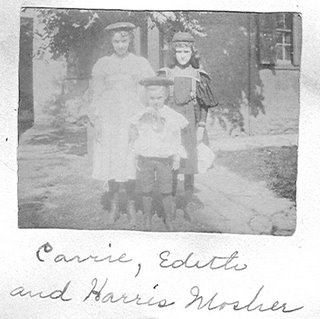
Children of John Jacob and Laura Henrietta Harris Mosher. Laura is the daughter of I.H. Harris by his second marriage to Carrie E. Bunnell.

There was always more than one tavern in the village of Waynesville. Another very early tavern was the "Holloway Tavern" on Third Street (1807). In 1810, David Hammell bought a lot in Miami Square he established a tavern. This tavern did not survive past 1824. The building later became known as the "Old Penitentiary." Another tavern was built on the northeast corner of North and North Main Street, known as the Miami House (also known as the Morrow House and the Cornell House), in 1826. In the 1880s it was named the Cornell House, owned by Samuel Cornell & Son. There was another tavern, a two story log building, located on the far north end of Main Street that continued until after the Civil War. It was built by Samuel Martin.
Consequently, there were originally three taverns/inns on the old Accommodation Stagecoach Line (Third Street):
On Main Street were four taverns/inns:
Also see, SOME HISTORICAL HOMES IN WAYNESVILLE for more information and pictures of the John Satterthwaite home, the Baily home and the Holloway Tavern.
Ad from the Miami-Visitor weekly newspaper, February 9, 1850
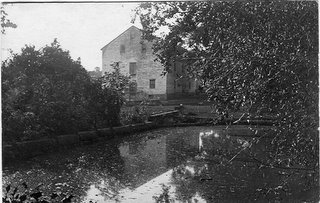
The Grist Mill at Waynesville ~ ca. 1900 ~ The "Upper Mill"
Dam on the Little Miami River (still extant)
Charles M. Robitzer's team of iron grey horses
and his delivery wagon.
Men cutting ice on the mill pond and storing in mill.
Below: Miller's House (yellow)
next to the Funkey-Evans House on North Main Street
Photographs of the Swiming Pool at
Mill Park in 1962.
The Little Miami River and local creeks were potent sources of water power and Waynesville was blessed with many mills ~ grist, saw and oil. Waynesville had a number of mills along the river, the "upper mills" (the Jennings mill property discussed above on the north end of town) and the "lower mills" (Elliott mill property on the south). Both the "upper" and "lower mills" consisted of a saw mill and a flour mill. Just a few miles further south of town were "Telegraph Mills" run by G. Hinchmann. Many more mills and factories could be found in all the villages and hamlets along the Little Miami River and its tributaries.

Funkey & Missildine’s Cash Trade Palace,
Miami-Gazette, August 27th, 1879
In 1881 Funkey opened another store where the Waynesville Antique Mall is located today on Main Street (see photo below dating from 1905).
John's wife Clara was 31 in 1879. They had two children: Pearl, a son(5) and Mabel P. (1). See, 1880 Census Place: Waynesville, Warren, Ohio; Roll: T9_1075; Family History Film: 1255075; Page: 473B; Enumeration District: 79; Image: 0360. John and Clara have two other children listed in the 1900 Census: George A. (18) and Eva M. (16) (see George and Eva's photographs below). See, 1900 Census Place: Waynesville, Warren, Ohio; Roll: T623 1330; Page: 3B; Enumeration District: 154. Also see, Waynesville’s First 200 Years, 1797-1997 (The Waynesville Historical Society, 1996), pp. 184-186.
According to Dennis Dalton (January 1982 from his 1970 notebook), John Funkey went on periodical drunken binges and the family would lock him upstairs in his room ~ once John jumped out the window and “nearly killed himself” to go drinking ~ one of his drinking friends was Perry Pence and John would “hunt all over town” for him and eventually “terrorized the village” with his drunken antics.
John F. Missildine was a dry goods merchant who had grown up in Waynesville. As a young man he labored on the farm and also taught school in the winter. In June 1865 he married Jemima Burnet who died in September 1868. He married to Druscilla McLary, age 30. They had five children by 1880: Oliver Oscar, 8, Ella J. ,7, Wilbur Howard, 5, Mary Etta, 4, and Cecilia, 2 (see, 1880 Census Place: Waynesville, Warren, Ohio; Roll: T9_1075; Family History Film: 1255075; Page: 489A; Enumeration District: 79; Image: 0390.). In 1895 John F. Missildine was the mayor of Waynesville from 1895-1900. Their sixth child was John Henry.
John F. and his family were some of the original communicants of St. Mary’s Episcopal Church in Waynesville (Waynesville’s First 200 Years, 1797-1997 [The Waynesville Historical Society, 1997], pp. 283 and 159). John F. Missildine was one of the Trustees on the board of the ill-fated Wayne Novelty Works Company in Waynesville. Below is a photograph of their home in Waynesville (white house):
John F. Missildine was a Quaker for a short period of time. According to the Encyclopedia of American Quaker Genealogy, Vol. 5, Ohio by Hinshaw, p. 101, he became a member on 9th mo. 26th day 1866 but was disowned for entering a marriage out of unity 8th mo. 26th day 1871.
The Brown family home:
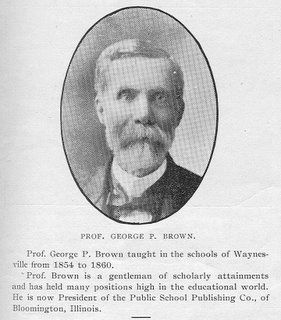
Photo and information taken from the
Souvenir & Homecoming Edition of The Miami~Gazette
October, 1906
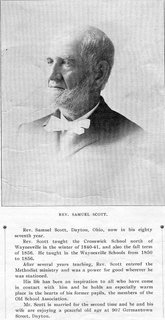
The above photo and information taken from the
Souvenir & Home-Coming Edition of The Miami-Gazette
October, 1906

Ad in the Miami ~Visitor newspaper, March 23rd, 1850